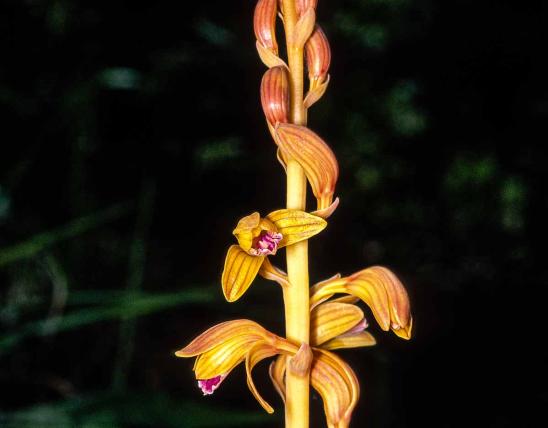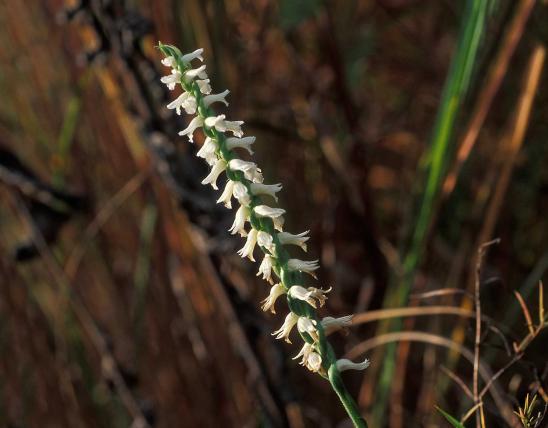
Showy lady’s slipper is one of Missouri’s most beautiful and rare flowers. It’s one of our largest orchids, a perennial wildflower reaching more than 3 feet in height and bearing 1, 2, or perhaps 3 flowers per stem. Stems and leaves are hairy; the leaves are narrowly ovate, with 3–10 per stem, 6–10 inches long, and more than 4½ inches wide. Flowers are positioned at the tips of the stems, each flower subtended by a leafy bract. The inflated, pouchlike lower lip of the flower is 1–2 inches long and is white, suffused with broad bands of rose-purple or pink. The sepals and petals are also white, oval, and somewhat blunt, and they are shorter than the lip. Unlike Missouri’s other lady’s slippers, its sepals and petals are not twisted. Blooms May–June. Fruits are upright, elongated, strongly ribbed capsules with up to thousands of tiny seeds.
Similar species: Missouri has only three species in the lady's slipper genus. Here are the other two:
- Small white lady’s slipper (C. candidum) has flowers whose purplish or brown-tinged “flags” twist (these are the upright sepal and two side petals); the inflated lower lip is white with purplish streaks on the inside surface. It is rare and found in only one location in extreme southern Missouri.
- Yellow lady’s slipper (C. calceolus) has two varieties in Missouri: small yellow lady’s slipper (var. parviflorum) and large yellow lady’s slipper (var. pubescens). Both have yellow flowers and twisted side petals.
The showy orchis (Galearis spectabilis) is in a different genus, but it might be confused with showy lady’s slipper because it, too, has showy pink and white flowers. Also, the names are confusingly similar! In this orchid, however, the lower lip is white and spade-shaped (not inflated like the toe of a slipper), and the upper petals are purple or lavender. It only reaches to about 8 inches in height. It is scattered nearly statewide, blooms April–June, usually in areas rich in spring wildflowers, and is one of the more common smaller orchids.
Height: 12 to 40 inches.
Restricted to the southern portion of the Missouri Ozarks, except for disjunct, historical collections from Putnam County. The global range includes the northeastern United States and adjacent Canada west to North Dakota and Missouri.
Habitat and Conservation
Occurs in seepy ledges of sheltered, north-facing dolomite bluffs, and less commonly along moist stream banks and in fens. Like other lady’s slippers, this species often forms colonies, and a colony in full bloom is a breathtaking sight.
Apparently, this species was formerly more common along stream banks than it is now. At present it is found primarily on seepy ledges of north-facing bluffs — places where it is inaccessible to would-be collectors.
Like other orchids, this species rarely survives transplanting and should never be removed from nature. If you see it, enjoy it in its natural habitat!
Status
A Missouri species of conservation concern, ranked vulnerable to imperiled. In most states and provinces where it occurs, it is considered vulnerable, imperiled, or critically imperiled. It has apparently been extirpated from some states, including Kentucky and North Carolina.
Human Connections
This is arguably one of Missouri’s most attractive wildflowers. Unscrupulous collectors have dug it extensively from the wild for use in gardens. Sadly, most of these die soon after transplanting because all orchids have obligate relationships with soil-borne mycorrhizal fungi and do not tolerate environmental changes well. If you are lucky enough to find orchids in the wild, enjoy them in their natural habitats. Take pictures! Treasure your memories.
Touching the hairs on the leaves and stems of this plant may cause dermatitis in some people.
This beautiful orchid is the state flower of Minnesota. There, it is protected by state law, and people may not dig up or even pluck the flowers of this plant in Minnesota. The Canadian province of Prince Edward Island had named this species as its official flower, too, but because of its rarity, they were forced to select another orchid as its floral emblem.
The genus name, Cypripedium, comes from Greek and Latin references to the goddess of love (Aphrodite or Venus) and “sandal.” The species name, reginae, means “of a queen.” A translation of the name amounts to "queen's Aphrodite-sandal."
In her 1984 memoir, Behind the Scenes, Cora Steyermark related the highlights of her many Missouri botanizing trips with her husband, Julian Steyermark. After providing some mind-blowing details about orchids’ insect-pollinator relationships and their seeds’ exacting germination requirements, she states: “Anyone who has any conception of the struggle an orchid must undergo to perpetuate itself would leave any member of this family in its natural habitat.”
Ecosystem Connections
Though it has a broad overall range, this species is rare nearly everywhere it is found. Habitat destruction and unscrupulous and illegal horticultural collection are the main problems.
Like other orchids, the intriguing form of the flowers is related to its use of pollinating insects. In this case, the flower has a special, one-way, almost maze-like route for its pollinators. Flower flies (syrphids), megachilid bees, beetles, and other pollinators must squeeze into the flower and cannot turn around to exit the way they came in; to leave, they must brush past the stigma (depositing any pollen on their body acquired from another flower) and rub past the flower’s own pollen masses before exiting through smaller openings on the side.
The usual pollinators for lady’s slipper orchids are various smaller bees, beetles, and flies, which are deceived into visiting the flowers by color and fragrance; the flowers offer no rewards (such as nectar) to insects. Occasionally, larger insects, such as bumblebees and moths, will enter the lip but are too large to pass through the exit holes and sometimes become trapped and die.
Professional horticulturalists have had great difficulty propagating this species, for many reasons. Although a single orchid fruit pod may produce more than 50,000 seeds, the tiny seeds have a low rate of germination and require the presence of particular kinds of beneficial soil fungi in order to survive for even a brief while. Additionally, they germinate and mature slowly; a showy orchid plant needs to be about 8 years old before it starts producing flowers. This helps explain why most showy lady’s slippers occur in colonies: they are reproducing asexually, via spreading rhizomes (rootstocks). It also helps explain why this plant is disappearing, rare, vulnerable, and imperiled. Once a population is wiped out, it does not come back.



































